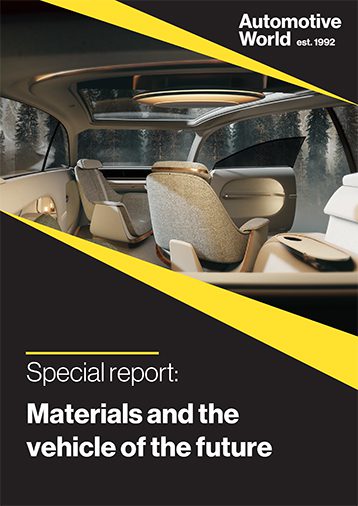The automotive industry is gradually converging with health and wellbeing trends as new technology enables OEMs to incorporate next generation features.
This is especially true in the luxury segment. For example, in 2022, Bentley added seats with massage and posture correction functions to help reduce driver muscle fatigue in models such as the Bentayga and Azure. That same year, Chinese start-up automaker BeyonCa announced that its GT Opus 1 would include a ‘personal health guardian’ to monitor the driver’s status and provide professional medical advice if necessary.
But will this focus on health soon extend beyond the luxury market? Hugh Rathbone, Chief Commercial Officer at supramolecular chemistry company Aqdot, believes that it could soon become an important brand differentiator across the industry. However, instead of introducing advanced in-cabin tech, it will start with a new approach to manufacturing interior materials.
Focusing on air quality
Improving air quality by removing pollutants and odours has been Aqdot’s focus since it launched in 2013. Originally spun-out from the University of Cambridge by researchers Chris Abell and Oren Scherman, the company closed its £11m (US$14.37m) Series C funding round in November 2021.
Rathbone reports that OEMs are increasingly concerned with reducing the odour of interior trim, and the COVID-19 pandemic has served to elevate its importance even further. “Awareness of air quality increased dramatically with COVID,” he states. “It started with viruses, now it’s about pollutants.” In 2021, a study by the University of California explored the effect of off-gassing (the release of trapped gases from materials) in vehicle interiors—commonly described as ‘new car smell’. It found that carcinogens such as formaldehyde and benzene reached levels unsafe for humans after just 20 minutes of driving.
Aqdot’s core powdered product, AqFresh, uses patented technology based on cucurbiturils. A mixture of these molecules can quickly bind to and eliminate a variety of volatile organic compounds (VOCs) and pollutants in the air. “The power of this technology has been known for 100 years, but the complex chemistry meant it was very difficult to make,” Rathbone tells Automotive World. “For five or six years, our founders learned how to manufacture it at multi-tonne scale.” This subsequently made it cheaper to produce and was the first step to introducing it to the automotive industry. Commercialisation began around the same time as the pandemic in early 2020.
AqFresh
The versatility of the AqFresh additive enables it to be applied wet or dry, from paint to plastics, textiles, and air fresheners. This provides automakers with a broad range of incorporation points, including door panels, carpets, seats, and headliners.
Used as a direct coating for polyvinyl chloride (PVC), an industry standard VDA 270 odour test found that it could reduce odours and VOCs from 3.4 points in the control (clearly perceptible) to 2.1 points (barely perceptible). As a transfer coating, the result was a reduction from 3.7 points (disturbing) to 2.7 points (not disturbing). Similarly, a polypropylene (PP) dashboard containing AqFresh brought down malodour levels from 3.7 to 2.3 points. Rathbone concedes that the subject material affects the overall speed at which Aqdot can provide an efficacious formulation. For instance, the simplicity of PP is unchallenging, whereas the various additives of PVC can add greater complexity to the process. However, the true challenge could prove to be growing industry awareness of the issue being resolved.
According to an Aqdot customer survey, 70% of automotive customers in Europe are currently concerned about the air quality of vehicles, but this falls to 52% in the US. “Americans seem to actually love ‘new car smell’,” observes Rathbone. Although US consumers might take some educating, he believes that reports of the associated health risks are gaining greater exposure. Research published in April 2023 by the Beijing Institute of Technology (Haimei Wang, et al) on the potentially increased risk of cancer from car interior VOCs was covered that same month by Forbes and the New York Post. “The awareness among both consumers and automakers is certainly changing,” he asserts.
A healthier car
While the importance of the issue is still nascent elsewhere, the Chinese industry is taking it far more seriously. China, states Rathbone, has been particularly conscious about indoor air pollutants because of deaths related to materials historically used in building construction over the previous decades. 84% of Chinese car owners are concerned about VOCs, according to Aqdot. This has filtered through to the nation’s automotive market, the size of which, Rathbone believes, could have the scale and influence necessary to tackle the issue globally. “China is setting the regulatory requirements and standards for European and US manufacturers, as well as domestic ones.”
The awareness among both consumers and automakers is certainly changing
There is evidence to suggest that this could eventually translate to a vector for competitive advantage. The same Aqdot survey also found that 77% of Chinese customers would be more likely to buy a car without ‘new car smell’, with almost the same number willing to pay extra to avoid it. Such a strong consensus is influencing business decisions. Although he cannot disclose specifics, Rathbone tells Automotive World that his company is currently working with “three OEMs, some of the largest car interior part Tier 1s, Tier 2s, and some rigid plastic Tier 3s.” These partnerships include proof-of-concept work and joint development agreements concerning malodour elimination and air purification.
For insight into how focusing on driver/passenger health and wellbeing could transform the global automotive industry, Rathbone concludes that European and US automakers should observe the Chinese market. “Almost every car in China has charcoal pouches to capture VOCs. These only have a marginal effect, but consumers are prepared to pay for them. If that demand can be met instead by creating augmented interior materials, we can provide better efficacy and a healthier car.”

